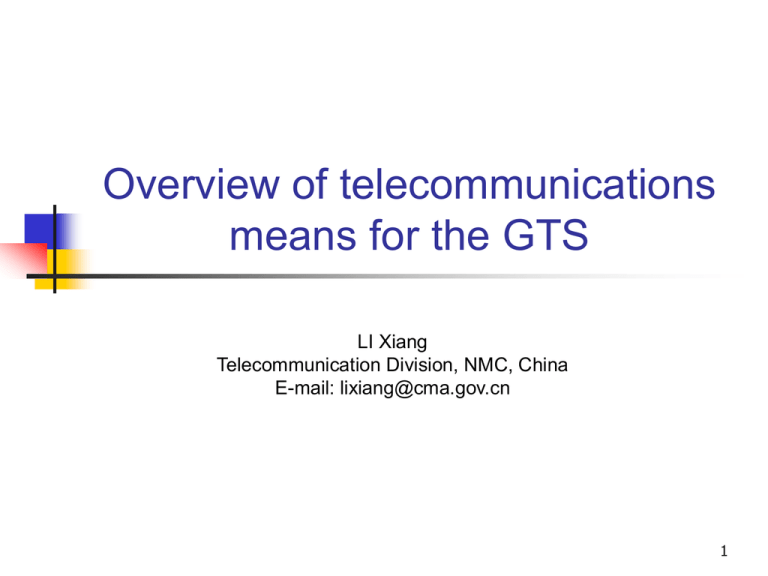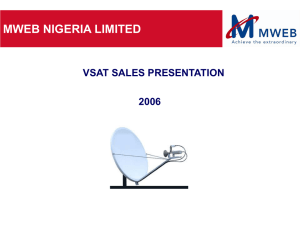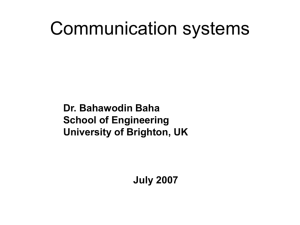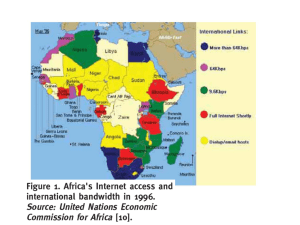leased circuits -analogue, digital-, data communication
advertisement

Overview of telecommunications means for the GTS LI Xiang Telecommunication Division, NMC, China E-mail: lixiang@cma.gov.cn 1 1. Leased circuits Data Communications Equipment: Converting the digital signals to the signals more suitable for transmission DTE DCE Data Terminal Equipment: - acting as sources or sinks for data communication link - Terminal/Computer DCE DTE Leased circuit: • point-to-point dedicated data transmission circuit between two points • leased by an organization from a telecommunication service provider • permanently open connection • medium: copper wire, optical fiber,... • signals: analog, digital 1.1 Analogue Circuits DTE At the source - digital to analogue conversion - modulate At the destination - Demodulate - analogue to digital conversion Phone PC + Communication Software Modem - a analogue connection - analogue signals Line Modem A digital connection, consisting of - a Transmit Data line - a Receive Data line - many hardware handshaking control lines. Features of analogue circuits Dedicated voice-grade circuit Using existing telephone cable network to provide a fixed and transparent connection between two points in the voice frequency band 300 - 3400 Hz Supporting low-speed data communication Typical date rates over analogue circuits are: 300, 1200, 2400, 9600, 14.4k, 19.2k, 28.8kbps Low costs 4 1.2 Digital circuits • source encoding/decoding • channel coding/decoding • synchronization Digital Modem PC + Communication Software circuit Modem - a digital connection - digital baseband signals Computer + Communication Software Features of digital circuits High quality communication links providing a fixed and transparent connection between two points terminated by a digital interface supporting high-speed data communication: 64Kbps – 155Mbps 6 1.3 Examples of use of Leased Circuits (1) Beijing – Moscow GTS link Physical link - analogue circuit Physical Layer - V.34 Data Link Layer - Link Access Procedure Balanced (LAPB) Network Layer - X.25 Packet Layer Protocol (PLP) 1.3 Examples of use of Leased Circuits (2) Beijing – Offenbach GTS link Physical link - digital circuit Physical Layer - V.35 Data Link Layer - Link Access Procedure Balanced (LAPB) Network Layer - X.25 Packet Layer Protocol (PLP) 1.3 Examples of use of Leased Circuits (3) Using TCP/IP protocol to exchange data over a leased circuit 2. Frame Relay A protocol standard for sending information, which is divided into frames or packets, over a wide area network. A fast and efficient packet-switching technology A Frame-Relay network doesn't perform error detection The intelligent network devices connected to a FrameRelay network are responsible for the error correction and frame formatting Frame Relay typically operates at 56 Kbps to 1.544 Mbps. Frame Relay is protocol independent, it can process traffic from different networking protocols like IP, IPX, and SNA. Multiple logical connections can be established over a single physical connection 10 Concept of Frame Relay communicate A Frame Relay Network router T H T FR data packet -Translating existing data communications protocols for transmission over a Frame-Relay network - Routing the data across the network to another frame router or other Frame-Relay compatible device - Handling many types of protocols, including LAN protocols - Each router supports one of many physical data interfaces and can provide several user ports. PVC FR data packet - Frame Relay sends information in packets called frames through a shared Frame-Relay network. - A frame contains all the information necessary to route it to the correct destination H B router DLCI: Data-Link Connection identifier, represents the address of the frame and corresponds to a PVC. C/R: Command/Response Field Bit, designates whether the frame is a command or response. EA: Extension Bit, can be used for expanding the number of possible addresses. DE: Discard Eligibility Indicator, provides the network a signal to determine which frame to discard. When there is a congestion on the line, in order to free the line, the network will discard frames with a DE value of 1 before discarding other frames. FECN: Forward Explicit Congestion Notification. If FECN is changed to 1 as a frame is sent downstream toward the destination location when congestion occurs during data transmission. BECN: Backward Explicit Congestion Notification. If BECN is changed to 1 as a frame traveling back toward the source of data transmission on a path where congestion is occurring. FCS: Frame Check Sequence CIR Committed Information Rate Instead of being allocated a fixed amount of bandwidth, Frame-Relay services offer a CIR at which data is transmitted. If traffic and the service agreement allow, data can burst above the committed rate. 13 PVC Permanent Virtual Circuits A PVC is a dedicated connection through the shared Frame-Relay network replacing a dedicated end to-end line. A PVC is needed for each site in the network. But in a Frame Relay network, the bandwidth is shared among multiple users. So any single site can communicate with any other single site without the need for multiple dedicated lines. PVCs function via a Local Management Interface (LMI), which provides control procedures. The control procedures function in three ways: link integrity verification initiated by the user device network status report giving details of all PVCs network notification of whether a PVC's status changes from active to inactive Data-Link Connections (DLCs) are PVCs pre-configured by both sides of the connection. The DLC identifier (DLCI) is used as the logical address for frame-layer multiplexing. 14 Examples of use of Frame Relay service KDDI Frame Relay Port 256K Router Sun Port 192K CIR 32K Sun JMA Router CMA CNC Frame Relay CIR 32K KT Frame Relay Router Sun Port 128K KMA 3. Introduction to VSAT,and satellite based DVB, DAB 16 3. 1 Introduction to VSAT Very Small Aperture Terminal Self-contained hub station Unbalanced traffic in outroute and inroute The utilization rate of VSAT network improved with the increase of remote terminals Support of broadcast 17 Types of VSAT network Star network: mostly adopted by data communications network. Full mesh network: mostly adopted by telephony communications network. Hybrid architecture: applied to integrated services network 18 Generally, VSAT systems operate in the Ku-band and C-band frequencies. Ku-band system Smaller sizes of VSAT antennas at remotes 0.6 ~ 2.4 m antenna Abundant in frequency resource Existing the propagation problems caused by rain C-band system Larger sizes of VSAT antennas at remotes 1.8 ~ 2.4 m antenna Most C-band frequency resource already used Existing the interference problem between adjacent channels because of the congestion of channels 19 Model of a transmission channel from one terminal to another (VSAT) satellite earth station PROCESSING DEMOD MOD earth station IF/RF RF/IF SATELLITE PROCESSING NETWORK STATION / TERMINAL INTERFACE STATION / TERMINAL INTERFACE USER TERMINAL DEMOD USER TERMINAL CMA’s VSAT system Communication Satellite Satellite: AsiaSat II Frequency Band: Ku-band Coverage: China and some other Asia countries adjacent to China Consisting of three parts Satellite telephony network Satellite Wide Area network One hub, about 350 remotes Full mesh network Covered regional, provincial and city level weather centers One hub, about 350 remotes Star network Covered regional, provincial and city level weather centers PCVSAT broadcasting system One hub, over 2000 remotes (including the remotes installed in Pyongyang and Ulan Bato)r Data broadcasting system Covered regional, provincial ,city and county level weather centers 21 SWAN Regional Centers National network center VSAT VSAT Control Control Center Center SWAN Server two-way system One outbound channel: 512kbps Eight inbound channels: 8*128kbps Remotes to Hub: ftp Hub to Remotes: multicast PBX TCP/IP CHINAPAC Provincial centers National operational centers City bureau CMA’s Intranet CMA’s PCVSAT data broadcasting network PCVSAT data broadcasting network LNB Multiplex PC Card PCVSAT broadcasting system One way system Broadcasting rates: 2Mbps Supporting 256 logical channels, the typical logical channel rate is 64kbps Authorization and management centralized at hub 3.2 Introduction to DVB DVB: international standard for digital video broadcasting Based on ISO 13818 MPEG-2 coding and multiplexing specifications 24 Types of DVB standards DVB-S DVB-C DVB-S satellite transmission standard, based on QPSK, is now the de-facto world satellite transmission standard for digital TV applications cable delivery mechanism, is closely related to DVB-S, and is based around 64-QAM, although higher order modulation schemes are also supported. DVB-T Based on COFDM (Coded Orthogonal Frequency Divisional Multiplexing) and QPSK, 16 QAM and 64 QAM modulation, it is the most sophisticated and flexible digital terrestrial transmission system available today. 25 Concept of DVB Signal Generation MPEG 2 digital compression coder Digital compression signals modulator Digital signals multiplexer Analog audio and video signals analogdigital converter DVB digital signals Data Server digital broadcasting or digitization TV program broadcasting amplifier video signal What a end user needs? Satellite dish PC DVB card 27 Why DVB? Smaller VSAT antenna Secure transmission with entitlement control Higher data rates, 256Kpbs – 58Mbps Support for Multi-protocol Encapsulation (MPE) of IP data Multiplexing of up to 8192 streams Integration of data with video and audio Co-existence between multiple DVB steams Multicast enabled Ease of implementation & upgrade Open architecture 28 3.3 Introduction to DAB DAB: Digital audio broadcasting Based on two techniques Musicam is a digital compression system based on MPEG technology makes the signal down to 10 times lighter provides an CD-like quality of sounds enables the association of data to the audio programmes (title, CD cover, author of the song) Digicast eliminates traditional reception problems (distortion, interferences, etc.) by spreading signals in time on several frequencies. The information that are broadcast separately remain linked by encoding. eliminates interferences ; propagation echoes become an advantage by enforcing the reception quality including in more complex areas. is able to send independently audio Streams (ex : Musicam) and Packet Datas (ex : NPAD) Operating via multiplexes. Each multiplex is composed of programmes and associated services. A sole transmitter can broadcast several programmes. The output can be up to 1.5 Mbps. Supporting Datacasting 29 DATACASTING : DATA BROADCASTING VIA DAB Procedures on data sending and receiving At the sending end, User’s data files being sent to the local uplink site of the DAB services provider, such as WorldSpace, via FTP or other means. The services provider‘s scheduler at the uplink site automatically picks up the data and places it into the defined bin at which point it is sent up to the satellite. At the receiving end, A PC-adaptor, connected to a satellite digital receiver and a PC transforms the receiver into a one-way satellite modem that can receive data at the rate up to 128 kbps. The delivered files are stored in the end user's designated directory on the hard drive. 31 Why DAB? Wide coverage DAB services: almost all over the world Datacasting: Africa and Asia Lower transmission costs for broadcasters : US$10 per MB Smaller antenna Wide choice of equipments at receiving ends Higher data rates Broadcasting rate: up to 1.5Mpbs Receiving rate: up to 128kbps 32 Thank you 33



